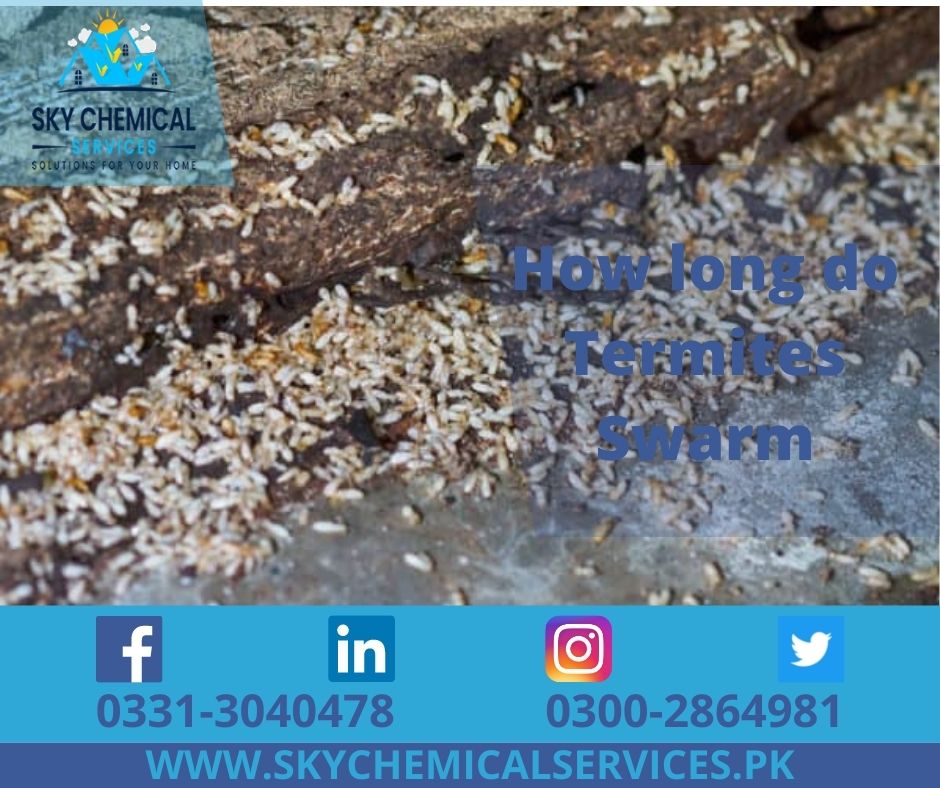
Termite swarms are a quick-moving phenomenon: one minute, there are no visible termites, and the next minute, there are. Several of these winged insects have emerged from their nest and are flying or crawling about the next minute. Hundreds, if not thousands, of termites will swarm out of their colony in less than a minute, ready to perpetuate their species. After an hour, the termites have returned to their old haunts within the walls of your home or inside a rotted wood outside. But how long do termites swarm, and how can you protect your home from these intruders? You will learn it in this blog.
Termite’s Life Cycle
While a termite swarm does not cause damage to your property, if you see one in or near your home, it signifies there is a termite colony living and thriving nearby, and this colony could be causing damage to the wood that makes up your house, garage, or other building. Termites feed on wood, which is why savvy homeowners try to keep them away from their homes, fences, pergolas, and garages. A termite colony can inflict significant damage that is costly to repair. To comprehend termite swarms and their consequences, one must first comprehend the termite life cycle. Each termite colony has a queen who lays thousands of eggs over the course of her life.
Signs of an Infestation
Termites shed their wings before mating and moving on to a new colony as they swarm to reproduce. If you see a clump of minute insect wings inside your home, usually on a windowsill or along a baseboard, you have a termite infestation—a colony of thousands of termites living inside your walls. Termite activity around light fixtures can also be seen in cracks in the walls, indicating the presence of a colony nearby. Subterranean and dry wood termites are the two most prevalent varieties of termites found in the United States, and they cause different levels of damage to homes and other structures.
Despite this, subterranean termites do not dwell in buildings; instead, they build their colonies in the soil, which supplies them with the moisture they require to exist. They still eat wood, therefore they build underground colonies near a food source, such as a home, tree, or wooden fence. The worker termites then construct mud tubes extending from their nest to the wood, which will feed the colony with all of the nourishment it requires. A subterranean termite infestation can be identified by long, narrow streaks of mud adhering to your home’s foundation or your fence near ground level.
Dry wood termites, like their subterranean counterparts, feed on wood, therefore if they establish a colony within a home, it will most likely be in the attic or under hardwood flooring. Dry wood termite colonies are often far smaller than subterranean termite colonies, which is why they cause less damage to people’s homes and belongings.
How can Termite Infestation lower your Home Value?
Chemicals used for Termite Proofing.
When do Termites Swarm?
Termites swarm in the spring, usually during the rainy season or immediately after it finishes, when the temperature is warm and humid. The specific time of year when local termites swarm varies depending on the section of the country you reside in, but termites’ reproductive activity normally takes place in mid- to late spring in most parts of the United States.
Swarms are a part of the termite life cycle; they occur after a termite colony has grown large enough that it’s time to breed and divide into new colonies, as we’ve already stated. The reproductive termites that mate and lay eggs will start a new colony and the queen of that colony will be the female reproductive.
If your house is increasing in pests and it requires an urgent cleaning, then contact Sky Chemical Services and book an appointment today.
Getting Rid of Swarming Termites
Homeowners can use a variety of strategies to prevent termites out of their houses and other locations around their property:
Maintain the condition of all fences and other structures on your property. If you have a rotting shed, fence, or other structure, repair or remove it to prevent termites from infiltrating your home.
Clear dead trees, logs, and other brush from your yard, or at the very least keep them away from your house and garage.
If you’re building a new fence, pergola, deck, or other outdoor construction, make sure to choose treated wood, which is treated with chemicals to keep termites at bay.
Have metal shields erected along the foundation to serve as a barrier between your home and any soil-dwelling subterranean termite colonies if you are building or renovating any component of your property.
Hire a termite specialist to inspect all of your structures, as well as your yard and trees, on an annual basis. ABC’s pest control experts are trained to recognize the characteristics of an active termite colony so that it can be treated and eradicated before any damage or spread happens.
How Termite Proofing in Karachi improve property cost?
Conclusion
Swarming termites are a menace to any residential or commercial plotting as they are a potent threat to wood and other substances. You can get rid of these termites by taking some tough measures; for instance, you can choose treated wood which keeps away these pesky creatures. You can also clean up your yard or store-room from dead wood or furniture. Learning about the termite life cycle is also essential, as it helps in fumigation and other processes.
If you like to know more about our services, visit (https://skychemicalservices.pk)
